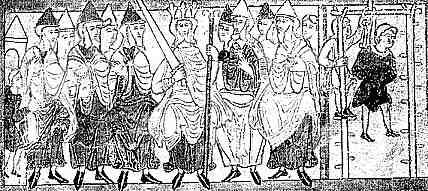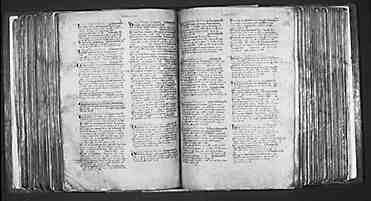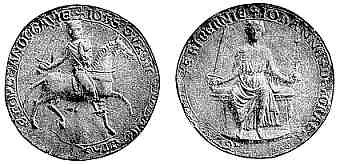



If you are looking at this page without frames, there is more information about medieval writing to be found by going to the home page (framed) or the site map (no frames).
| English Chancery Records | |
| As indicated in other sections, the processes of bureaucracy and law only gradually became literate in England. The Anglo-Saxon kings issued diplomas as land deeds. The Old English vernacular writ became a document with the force of a legal title during the reign of Edward the Confessor. Latin charters, based on the form of the vernacular writ, were issued by the Norman kings. None of these were systematically archived. The beneficiary of a charter or writ had to hang on to the document and produce live witnesses if necessary to validate their claims. | |
 |
|
| An Anglo-Saxon king and his witan, or council, from an 11th century manuscript in the British Library. | |
| The most significant matters were determined by what was essentially oral process. | |
| Information on the development of the records can be found in Clanchy 1993, Elton 1969, Galbraith 1949 and Galbraith 1952. | |
| The compilation of Domesday Book was perhaps the first attempt at systematic archiving of written information in medieval England. The preservation of other documentary material in this era is fortuitous. The royal treasury did retain copies of some important outward correspondence, called contra brevia, but the process of preserving them was not orderly or effective. Copies of privileges granted by the crown were not retained in a systematic way by the Chancery. In fact, it is not entirely clear when the Chancery became a formal body with its own structure and authority, as opposed to a bunch of scribes employed in the service of the king. | |
 |
|
| The main volume of Domesday Book, preserved in the National Archives, London. | |
| The Chancery developed from the royal household. A long term continuing reminder that the church was the original home of Latin literacy was embodied in the fact that the Chancellor, throughout the medieval period, was a senior ecclesiastical figure, clericus and litteratus. Chancery clerks could be priests holding benefices in parishes they never saw. The king did not drop in on his local monastery when he needed a bit of writing done, but the royal chancery was never fully separated from the church throughout the middle ages. | |
| In 1199, after the accession of King John and under the management of the Chancellor, Hubert Walter, the procedure began of recording copies of significant documents issued by the Chancery on rolls. This postdated the practice of enrolment by the Exchequer, or financial arm of government, by over 60 years. This event represents some separation of the functions of Chancery and Exchequer and the beginnings of development of bureaucratic complexity. It also represents the birth of systematic archiving. The increasing desire of kings to confirm pre-existing charters on their succession may have been part of the motivation for this development. The rolls consisted of membranes of vellum stitched together to form very long documents of around 20 membranes, from which individual entries could not be abstracted, or, for that matter, inserted retrospectively. | |
| The rolls, as with the original documents which they copied, were in Latin, the language of liturgy and law rather than the vernacular of the aristocracy, French. In the first year, all documents under the great seal, including charters, writs, letters patent and letters close, were entered on one single roll together. | |
 |
|
| A single entry from the first surviving charter roll of 1199 (London, National Archives, Charter Rolls, No. 1). (From The New Palaeographical Society 1913) | |
| The above example is at too small a magnification to read, but it is produced in a neat, compressed script of less formality than the chancery hand used for formal charters, and there is much abbreviation. Apart from abbreviation of entirely formulaic sections, such as etc inserted after the name of the king to cover his titles, it attempts to be an accurate transcript, not an abstract, of the original document. | |
 |
The great seal of King John, showing both sides of the double sided seal. |
| The term great seal refers not only to the large and elaborate lump of sealing wax bearing on one side, an equestrian figure of the king and on the other, an image of the king in majesty with sword and sceptre. It also referred to the office or secretariat which produced documents under the great seal. This was the earliest and most significant of the Chancery secretariats and documents generated under the great seal had the force of law. Charters and letters patent actually had the seal attached, while letters close were less formal affairs which did not warrant the attachment of the huge wax sculpture. The privy seal evidently existed at this time, but its mode of functioning is not known. | |
|
|
|
|
If you are looking at this page without frames, there is more information about medieval writing to be found by going to the home page (framed) or the site map (no frames). |
|